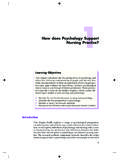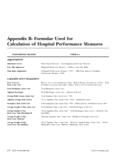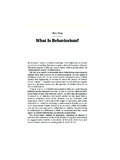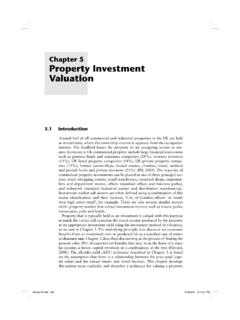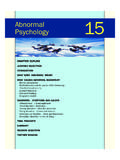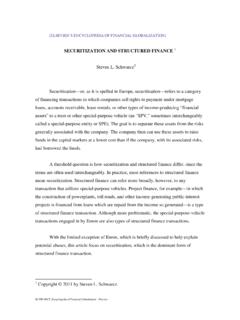Transcription of Davis / Blackwell Encyclopedia of Management: Information ...
1 Aabsorptive capacity and informationtechnologySusan A. BrownAbsorptive capacity is the ability to identify,assimilate, and exploit external Information (Cohen and Levinthal, 1990). This ability in anorganization derives from a foundation of indi-vidual knowledge and organizational mechan-isms for knowledge sharing. Some overlappingknowledge among individuals is necessary tofacilitate knowledge sharing; however, a diversebase of knowledge is required across individualsfor the organization to recognize the value of awide variety of new knowledge. The concept isapplicable to Information technology applica-tions because the applications employ newmethods and technologies introduced from out-side the organization or outside a particularfunctional unit, thus requiring employees to rec-ognize the value of something new.
2 Some organ-izations, and functional units within them, areable to introduce radical changes in systemsmore rapidly than others. One explanationis the difference in their relative of absorptive capacity in infor-mation systems have focused on identificationand implementation of new Information technol-ogy and systems and the relationship betweenabsorptive capacity and organizational learning/knowledge management. Research suggests thatunderstanding how knowledge about the busi-ness and knowledge about technology overlapamong employees is important in determiningorganizational ability to identify and implementnew Information technologies ( , Boynton,Zmud, and Jacobs, 1994). In this case, the higherthe absorptive capacity, the greater the ability toincorporate new technologies.
3 Low absorptivecapacity suggests the need to improve know-ledge, mechanisms for sharing knowledge, orboth. One technology approach to enhancingthe knowledge sharing in an organization isthrough the use of a knowledge managementsystem. Thus, one benefit of a knowledge man-agement system may be its contribution to theabsorptive capacity of the , A., Zmud, R., and Jacobs, G. (1994). The influ-ence of IT management practice on IT use in Quarterly,18, 299 , W. M. and Levinthal, D. A. (1990). Absorptivecapacity: A new perspective on learning and Science Quarterly,35, 128 use of Information technologyC. Janie ChangAdvances in Information technology (IT) arepervasively affecting every aspect of the account-ing profession. IT has made many companiesmore efficient and accurate in performing ac-counting, internal audit, and tax functions.
4 Theuses of IT in accounting are reflected mainly inaccounting Information systems (AIS) and inhow accounting -related Information is AIS collects, stores, processes, and reportsinformation regarding the financial transactionsof an organization. One major objective of anAIS is to provide internal control over the pro-cessing of transactions. This control is necessaryto insure the organization s financial activitiesare recorded and reported accurately, fairly,and on a timely basis. The increasing importanceDavis / Blackwell Encyclopedia of Management: Information System Final Proof 2:46pm page 1of AIS is manifested by the scandals of Parma-latte in Italy and Enron and World Com in theUS. There is an obvious worldwide trend ofincreased emphasis on internal controls over in-formation systems.
5 A particular importantexample is the US Sarbanes-Oxfley Act. ThisAct, developed in 2002, currently is enforced bythe US Securities and Exchange Commission(SEC) through rule making for publicly tradedcompanies requiring them to maintain good in-ternal controls of their Information systems are the mostcommon Information systems utilized in busi-ness. In general, they are a combination ofmanual (people-oriented) and automated (com-puter-based) components that work together toaccomplish accounting system objectives. Dueto the enterprise-wide role of many accountingapplications, an organization s set of integratedaccounting applications may be its largest infor-mation system. During the past decade, manyfirms have chosen to implement integratedsystems to eliminate most manual parts of theiraccounting Information Information systems should per-form business data processing with well-designed internal controls.
6 In the input stage,the system collects and records data, such assales/purchase orders, shipping/receiving data,and vendor/customer payments. If necessary,data from non-machine-readable documents(such as a handwritten price tag) are enteredinto machine-readable form for use in subse-quent computerized the processing stage, an AIS performs pri-mary accounting operations, utilizing the datathat were collected in the input stage. Themost common data processing operation is theupdating of organizational files and databases toreflect the completion of a transaction. IT hasproved advantageous in processing accountingdata in which rote calculations are involved andin linking financial records and tax records. Forthe past few decades, IT has been used to im-prove various accounting functions, such as thecalculation of depreciation and amortization onassets and the printing of payroll checks andindividual tax reports from electronic payrolldata.
7 Some accounting applications handle suchfunctions as the flow of data from financialrecords to tax the output stage, an accounting systemproduces documents that describe financialtransactions that have been processed. Thesedocuments can describe single transactions oraggregated transactions. At the single transac-tion level, customer sales orders and bank de-posit receipts are examples of outputs. Examplesof outputs that depict aggregated transactionsare corporate financial statements that summar-ize the financial transactions in which an organ-ization has engaged during a specified period oftime. The most important recent application ofIT to improve financial reporting capabilities isthe XBRL (Extended Business Reporting Lan-guage). Developed in 2000, XBRL is an XML-based specification for preparing, distributing,and analyzing financial Information (seexml(extensible markup language) ).
8 XBRLhas been named as the next-generation digitallanguage of business. It is expected to improvethe integrity of electronic financial reports bystandardizing financial reporting over theInternet. Companies will be able to use theweb to report financial Information in a timely,accurate, and understandable the advances in IT and web-based access,companies anywhere in the world can accessfinancial Information on companies that tradeon the major stock exchanges and can accessrules and regulations related to accountingstandards and other documents. For example,the US financial accounting StandardsBoard (FASB) website has Information on cur-rent activities related to drafting and reviewingnew accounting standards and of the various pronouncements can beordered directly from the FASB website.
9 Also,the SEC website has many types of items thatpreviously could be obtained only by subscribingto a commercial service or by requesting themfrom the SEC. With the web, this informationis available immediately at no cost. TheSEC website provides links to statutes, pressreleases, special reports and studies, and regula-tory actions. In addition, the well-known EDGAR service on the SEC website( ) allows visitors to view or down-load copies of the financial reports (such as10-Ks) filed by publicly traded accounting use of Information technologyDavis / Blackwell Encyclopedia of Management: Information System Final Proof 2:46pm page 2 Similar access is available from regulatory agen-cies in other Association for Computing Machinery isthe largest broad-based international computerand Information system society (seeassoci-ations and societies for informationsystems professionals).
10 ADAADA is a general-purpose programming lan-guage sponsored by the US Department of De-fense. It is especially suited for the programmingof large, long-lived systems with a need for structured techniques and Acrobatseeportable data formatagency theory applied to informationsystemsSoon AngAgency theory examines the contracts between aparty (the principal) who delegates work to an-other (the agent). Agency relations becomeproblematic when the principal and agent haveconflicting goals and when it is difficult or costlyfor the principal to monitor the performance ofthe agent. When goals are incongruent, the agentis assumed to have a different set of incentivestructures from the principal; the agent will con-sume perquisites out of the principal s resourcesand make suboptimal decisions.




